Expand the View
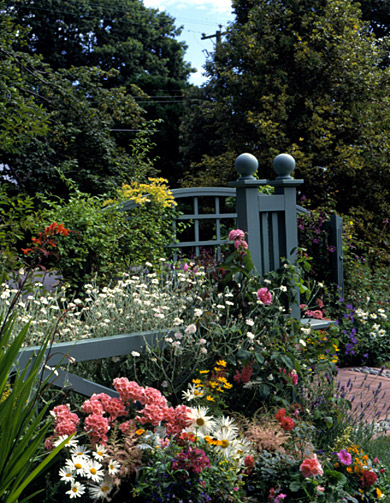
The right fencing adds to a garden's beauty.
- Hide a bad view strategically with a trellis or tree, but don't block off everything. And remember one view you can always have: the sky. Keep an open space so you can see it.
- Low fences, 2 or 3 feet high, can help you create spaces within the garden. Even a short fence creates wonderment about what's on the other side. Any yard will seem larger if you can see beyond it, so keep the fencing low.
- Eliminate some deck railings if your deck is less than 3 feet high, or choose a railing element, such as narrower slats or coated wire, with less visual weight.
- Prune trees high, or choose small-leaf species, such as locust, honey locust, or Japanese maple that produce light, filtered shade.
- Choose an open design, such as widely spaced slats, if you need a border fence.
- Mask a solid fence with a vine, or try the ultimate theater-prop technique: Paint a scene to make it look like the landscape you don't have.
- Mix the geometry of angles, circles, and lines into structures, paths, borders, and fence lines to create fresh perspectives at every step.
Trim your maintenance time with our fresh tips.
continue reading below
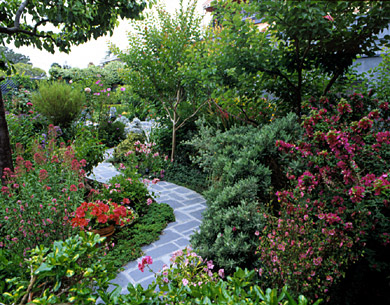
A mix of materials and colorswill keep visitors intrigued.
- Don't flow the landscape design end-to-end from front to back. Work back and forth across the grain, either straight across, diagonally, or meandering, to add rhythm and interest.
- Change materials or patterns.
- Define several garden rooms or areas.
- Use a theme to carry the design through the layout. For example, several cone-shape conifers placed strategically throughout the landscape can at once unite the scheme and create a sense of space. You can also set a theme with color or structure repetition.
- Draw attention to corners, such as a path that bends out of sight. Even if there's not much around the bend, it creates the impression that there is.
- Use color. Red draws closer; blue fades away.
- Create a sense of volume with a few large building materials, such as pavers or beams. A large, clean pattern creates more openness than a small, concentrated, busy pattern.
Encourage Lingering
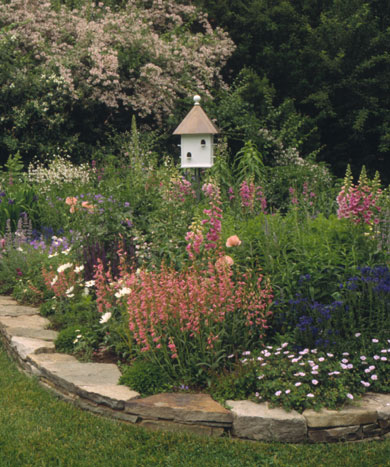
Get the attention of garden guestswith attractive displays.
- If you can slow people down in viewing or touring the garden, it will feel bigger to them.
- Use curving paths.
- Add garden sculpture (a sundial, a cascading birdbath) or an intriguing plant (a topiary, a twisted witch hazel) to make people stop to look.
- Add motion, such as a wind chime or ornamental grasses.
- Limit the lawn. Detail -- textured stones, woodwork, and plants -- draws interest and slows down the viewer.
- Use smooth, loose gravel for paths. Though safe, it requires careful -- and slower -- walking.
Adjust Heights
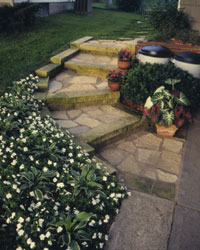
A variety of levels add visual depth.
- Going up or down creates the impression of entering a new place, even if you're not. It also slows you down.
- Try a multilevel deck, a patio that steps into the yard, or a berm or bridge in the landscape instead of a flat path.
- Build raised beds. They bring plant material higher, allow material to drape casually down, and, like a bookcase, create a display area.
Learn how to build a raised bed.
- Hang window boxes to add some garden space head and shoulders above the rest.
Get window box inspiration.
- Try a wall planter or a hanging basket where a window box won't work.
Build Up
Take a cue from big cities: When things get too crowded at ground level, build up.
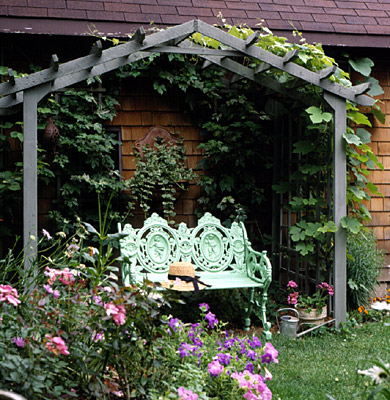
Tall plants and structures can help
make a garden seem bigger.
- Use covered benches or trellises to put interesting architecture or vines overhead.
- Choose trees with foliage, fruit, bark, or branching habits that inspire you to look up.
- Try vines. Grow them on strings into trees, on freestanding trellises, up fences, or on tepees.
- Feed the birds. They create an instant sense of freedom or space and will pull your attention into the trees or the sky.
- Install a weather vane. Whether on a low post or stump or higher on a shed or rooftop, it helps you notice the wind and sky.
- Choose vertical fence designs.
- Plant some tall poles or pillars. Mount a birdhouse on top, or hang planters on them.
Make Space for Reflection
No matter how small your landscape, there's always room to daydream.
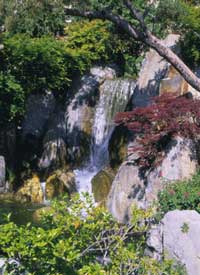
Running water is a soothing sound.
- Water, even a small pond, can conjure escapes. Still water reflects the sky and adds depth and dimension. If stocked with fish, the pond creates another point of interest.
Get water garden ideas.
- Place a conversation centerpiece in the gathering area, such as a fireplace, a nifty piece of garden art, or even a sculpture made by you or your kids.
- Set a gazing globe where you can see it and the distorted reflection of the landscape.
- Use some running water in the landscape. A waterfall is pleasant to watch and listen to. If you hide the source of the trickling, it creates an impression that there's more landscape out there.
- Create one or two focal points (a birdbath, artwork, or attractive plant) for each seating area.
- Attract wildlife to make the space more entertaining. Lure squirrels and birds by feeding them, furnishing water or a birdbath, and providing cover.
Use Every Inch
When there's not much yard to be had, make sure you have all of it. Don't ignore a dark corner, a hard-to-reach place, or any other underused area.
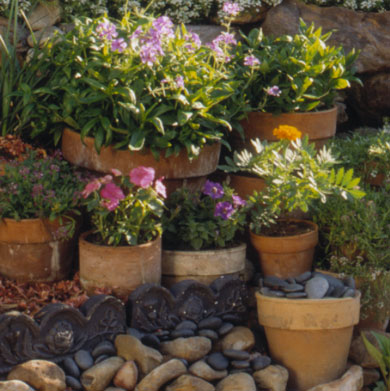
Add color and greenery to asmall corner with potted plants.
- Use the front yard. Don't corral everything in back. Garden in front, or create a sheltered bench, patio, courtyard, or another getaway.
Learn our front yard landscaping secrets.
- Plant along the side of the house. Trellis some vines, plant some containers, and use a path.
- Grow a vine on a trellis around the garage door or on a garden structure.
- Create a compost bin or a stall to store the wheelbarrow in the wasted area behind a shed.
- Use containers to fill any dead spot or to brighten the smallest empty corners.
- Bring the garden inside, or blur the edges of house and garden. Install a greenhouse window or sunroom, or plant and landscape up to your doors, perhaps framing them with an arbor.
Small Space Yard Tips
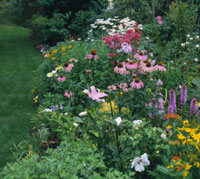
Choose a variety of plant sizes andheights.
- Layer plantings. Create a lot of action in a small space by planting big bulbs under small bulbs. Grow perennials and annuals on top, and let a vine or shrub stand above the entire vignette.
- Blend vegetables and ornamentals. A produce garden by itself may eat up too much space. You may have to forsake some sprawlers, such as pumpkins or cucumbers.
- Plant in clusters rather than rows if you prefer a vegetable bed. Grow in containers, or grow vertically, such as pole beans instead of bush beans.
- Think mini, such as alpine plants and succulents.
- Look for key words such as dwarf, horizontalis, nana, compacta, and columnus when choosing plant varieties.
- Try a Japanese garden, ideal for small spaces, with gravel, stones, a focal point, and small plants such as Japanese maples, hollies, Andromeda, yews, and Asian azaleas.
- Espalier small trees into space-smart shapes.
- Trim hedges thin, about a foot or two. Don't, however, cut down to the old-wood cores.
- A common mistake is to fill a small space with plants that are small. Instead, if you don't have much room, you'd better make sure every plant is one you really want.
More Space-Enhancing Ideas
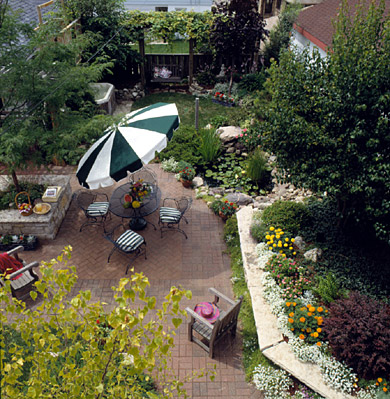
Setting off a variety of activity areasmakes a space seem bigger.
- Create small vignettes in flower beds. Move plants around to find the best combinations. Set a basin of water on the ground and let an attractive plant, such as a bleeding-heart or rose, dangle over it. Blend shades of green.
- Leave some strategic open spaces. A wide, roomy path speaks for itself.
- Try to create several seating areas, if only a single bench or chair, for a selection of views. Consider views from the house to the far end of the lot, and the opposite.
- Paint cumbersome structures a neutral color to downplay them.
- Carve a niche out of a hedge to display statuary, rather than setting the statue in front.
- Stay simple. Work with your natural surroundings and the flow of your property.
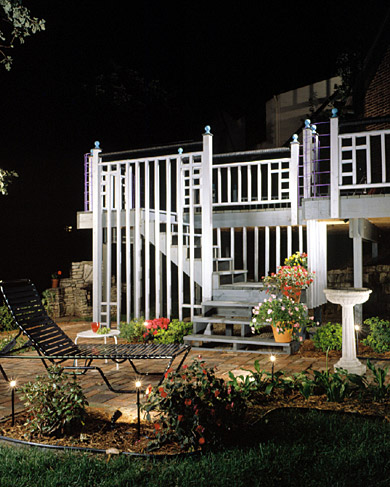
Lighting adds function and focus.
- Use lighting to highlight the best features and to draw the eye to the far end of the property.
- Save space with built-ins, such as deck rails that double as seating, built-in cook centers, and hideaway storage under benches.
- Choose small-scale or folding furniture. A patio table big enough for eight people stays big enough for eight people even when no one's there.
- Select airy furniture. Glass-top or wrought-iron tables seem smaller than a solid version.
- Do what you enjoy. If the space has personality and you like it, it won't seem so small.
Get more great small-yard inspiration.






 The right fencing adds to a garden's beauty.
The right fencing adds to a garden's beauty.
 A mix of materials and colorswill keep visitors intrigued.
A mix of materials and colorswill keep visitors intrigued.
 Get the attention of garden guestswith attractive displays.
Get the attention of garden guestswith attractive displays.
 A variety of levels add visual depth.
A variety of levels add visual depth.
 Tall plants and structures can help
make a garden seem bigger.
Tall plants and structures can help
make a garden seem bigger.
 Running water is a soothing sound.
Running water is a soothing sound.
 Add color and greenery to asmall corner with potted plants.
Add color and greenery to asmall corner with potted plants.
 Choose a variety of plant sizes andheights.
Choose a variety of plant sizes andheights.
 Setting off a variety of activity areasmakes a space seem bigger.
Setting off a variety of activity areasmakes a space seem bigger.
 Lighting adds function and focus.
Lighting adds function and focus.